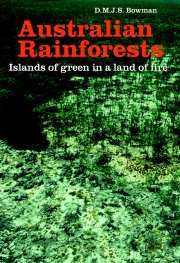Book contents
- Frontmatter
- Contents
- Preface
- 1 Introduction
- 2 What is Australian rainforest?
- 3 The sclerophyll problem
- 4 The edaphic theory I. The control of rainforest by soil phosphorus
- 5 The edaphic theory II. Soil types, drainage, and fertility
- 6 The climate theory I. Water stress
- 7 The climate theory II. Light and temperature
- 8 The fire theory I. Field evidence
- 9 The fire theory II. Fire, nutrient cycling, and topography
- 10 The fire theory III. Fire frequency, succession, and ecological drift
- 11 The fire theory IV. Aboriginal landscape burning
- 12 The fire theory V. Aridity and the evolution of flammable forests
- 13 The fire theory VI. Fire management and rainforest conservation
- 14 Summary
- References
- Index
4 - The edaphic theory I. The control of rainforest by soil phosphorus
Published online by Cambridge University Press: 23 November 2009
- Frontmatter
- Contents
- Preface
- 1 Introduction
- 2 What is Australian rainforest?
- 3 The sclerophyll problem
- 4 The edaphic theory I. The control of rainforest by soil phosphorus
- 5 The edaphic theory II. Soil types, drainage, and fertility
- 6 The climate theory I. Water stress
- 7 The climate theory II. Light and temperature
- 8 The fire theory I. Field evidence
- 9 The fire theory II. Fire, nutrient cycling, and topography
- 10 The fire theory III. Fire frequency, succession, and ecological drift
- 11 The fire theory IV. Aboriginal landscape burning
- 12 The fire theory V. Aridity and the evolution of flammable forests
- 13 The fire theory VI. Fire management and rainforest conservation
- 14 Summary
- References
- Index
Summary
In an insightful paper, Andrews (1916) suggested that the dominant Australian flora was originally derived from rainforest and had undergone extreme morphological modifications in order to cope with infertile soils. This view was subsequently elaborated by the ecologist Beadle (1953, 1954, 1962a,b, 1966, 1968), who argued that the restricted distribution of Australian rainforests is caused by the widespread exhaustion of soil phosphorus through geological time. Beadle (1966) took this view to the extreme by stating that ‘the absence of rainforest and the paucity of rainforest genera in south-west Western Australia are accounted for by low [soil] fertility levels rather than by a decimation of rainforest genera by a past dry climate’. As discussed in the previous chapter, Beadle argued that the non-rainforest ‘sclerophyll’ vegetation owed its dominance to physiological characteristics that enabled it to survive on infertile soils, particularly those with extremely low levels of phosphorus.
Beadle (1953, 1954, 1962a, 1966, 1968) supported his hypothesis by examination of correlations and some experimentation. Although his hypothesis has received general support (Ashton 1976a; Attiwill et al. 1978; Webb 1969) and only limited criticism (Coaldrake and Haydock 1958; Le Brocque and Buckney 1994), there have been few tests of the hypothesis (Coaldrake and Haydock 1958; Richards 1968; Adam et al. 1989; Le Brocque and Buckney 1994). The purpose of this chapter is to demonstrate that available data do not support the generalisation that rainforest is restricted to soils with high soil phosphorus levels.
- Type
- Chapter
- Information
- Australian RainforestsIslands of Green in a Land of Fire, pp. 68 - 83Publisher: Cambridge University PressPrint publication year: 2000



